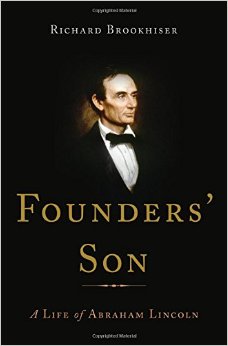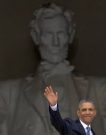Lincoln and the Fathers
Sons’ relationships with fathers are never simple. Richard Brookhiser’s account of Abraham Lincoln’s connection to the Founding Fathers from whom the statesman politically descended is estimably rich. Founder’s Son: A Life of Abraham Lincoln is a biography that seeks not to narrate every detail of its subject’s life, but rather to establish a perspective from which it has not yet been explored in depth: Lincoln’s intellectual connection to the American Founding.
Brookhiser plainly admires his subject, but does not deify him. Lincoln appears in these pages as wholly human. Indeed, one of this book’s striking features is how utterly normal Lincoln seems, until his greatness of soul fills the space opened when the Kansas-Nebraska Act exposed the moral wound of slavery and precipitated the crisis of 1856.
This immensely disciplined account does not attempt a full-scale life of Lincoln or his age. Gettysburg gets a paragraph that simply concludes: “After three days of fighting, the invaders withdrew, beaten.” Even the assassination (“Booth entered the Lincolns’ box and shot the president in the back of the head”) does not distract Brookhiser from his purpose. This constriction of focus, and forsaking of pathos, magnifies the purpose of Brookhiser’s tale, which is to explore Lincoln’s connection to his political forebears.
That connection is fraught not only for Lincoln but for the generations of scholars who have sought to understand it. In certain quarters, Lincoln at Gettysburg is understood to have restored the Declaration of Independence to its proper place as the orienting star in the Founding constellation. Elsewhere, he is regarded as having derailed the constitutional tradition at the same place. Brookhiser himself seems untouched by these debates, attempting—following Lincoln’s hand—to see his subject as reconciling the Declaration and Constitution to one another.
He also links Lincoln with other Founders. None exceeds Washington’s importance. Lincoln inhaled Parson Weems’ Life of Washington as a boy; its apocrypha fascinated him, and flitted through his rhetoric the rest of his life. “You all know, for you have been boys,” he tells the New Jersey Senate in an 1861 speech, “how these early impressions last longer than others.” Brookhiser observes that the lesson drawn from Weems’ Life, which Lincoln conveyed in the New Jersey speech, rose from Washington’s exhortation to his troops as they marched on Trenton: “All I ask of you is, just to remember what you are about to fight for.”
As Brookhiser puts it:
Lincoln remembered. He told the New Jersey Senate that he wanted to perpetuate liberty and Union “in accordance with the original idea for which that struggle”—at Trenton and other battles—“was made.” Washington and his men had defended liberty, Lincoln and the nation must be ready to defend her again. Washington’s task was now his.
Brookhiser qualifies Thomas Paine as a major influence on Lincoln. This claim is more tenuous, both Brookhiser’s placement of Paine in those ranks—he acknowledges that “Paine sits a little uneasily among the founding fathers”—and his connection to Lincoln. He asserts that Lincoln read Paine—he does not say what, or supply any commentary on it left by Lincoln—then embarks on a sustained exploration of the latter’s The Age of Reason (1796), an attack on Biblical Christianity.
Paine’s views are not attributed to Lincoln, nor would there seem to be much basis for doing so, but an aura of suggestion hangs heavily over these pages. The passages on Paine set up a discussion of what Brookhiser portrays as Lincoln’s youthful irreligion, which feels like the opening scene of a drama whose conclusion—certainly the statesman’s later rhetoric is infused with Christianity—is not fully staged.
Brookhiser is on firmer ground when he attends to Lincoln’s own words about the Founding Fathers, as he does, for example, in a lengthy treatment of the 1838 Lyceum Address. He portrays Lincoln’s admonition that the glory of Washington’s generation is no longer available as a banishment of the Founding Fathers to the past. This was not quite Lincoln’s point—he had said their example should still inspire—but Brookhiser’s treatment of the speech, including his contextual portrait, is both provocative and illuminating. His connection of the speech’s emphasis on reason to Paine will intrigue even those it does not fully persuade.
So will Brookhiser’s fascinating connection between Lincoln and his fellow Whig Congressman, Georgia’s Alexander Stephens, who would later become Vice President of the Confederacy. The correspondence between the two, between the election of 1860 and Georgia’s secession (which Stephens initially opposed), assumes a tragic dimension.
Lincoln’s views on slavery evolve in this telling as they did in his life: incrementally, but animated by consistent principle. As early as 1837, while registering disapproval of abolitionism, he and a colleague in the Illinois legislature declared that “the institution of slavery is founded on both injustice and bad policy.” At the end of his term in the U.S. House of Representatives, he futilely proposed gradual emancipation in the District of Columbia.
In this plan as at other times, Lincoln weighed evil against good, the evil of slavery against the prudential—and theoretical—goods of republican self-government. For Brookhiser’s Lincoln, these republican goods are embodied in the Declaration and the Constitution. Henry Clay leads Lincoln to the former, but Lincoln’s genius lies in attempting what Clay (and John C. Calhoun, Daniel Webster, and the other leading elder statesmen of the time) found impossible: balancing the two.
Eulogizing Clay in 1852, Lincoln proclaimed that the Whig titan’s “predominant sentiment, from first to last, was a deep devotion to the cause of human liberty. . . . He loved his country because it was his own country, but mostly because it was a free country.”
The Kansas-Nebraska Act, which repealed the Missouri Compromise and allowed the expansion of slavery into the territories, threatened that value, and it awakened, or perhaps provided a theater for, the greatness of Brookhiser’s Lincoln. It also required the then-private citizen, who had thought his political career over, to attempt to reconcile the values of self-government and liberty. He did so by arguing, in his Peoria Address, that the right to self-government included the right of African-Americans to govern their individual lives:
The founding fathers marched through Lincoln’s speech—no longer dead and gone, but living presences. He invoked the “pure, fresh, free breath of the revolution” as he began his oration, and “the principle of the REVOLUTION (Lincoln’s capital letters) as he wound up. He insisted that his position on slavery was the founders’ position.
Here we arrive at the essence of the matter, for Lincoln’s reference to the Revolution rather than to, say, the Philadelphia Convention of 1787, is of course a deliberate and significant choice. “Our republican robe is soiled, and trailed in the dust,” said Lincoln. Let us repurify it. Let us turn and wash it white, in the spirit, if not the blood, of the Revolution.”
Brookhiser presents the Lincoln-Douglas debates, too, as a struggle over the meaning of the Founding, especially the Declaration. Senator Douglas of Illinois openly declared his belief that the Declaration excluded non-whites; his challenger replied that Founding documents—the Declaration, Northwest Ordinance, the Constitution—were rife with “marks of disapprobation” of slavery. Again Lincoln invoked the Revolution—and, as Brookhiser reads him, cast slavery’s defenders in the role of George III. Slavery was based on the principle that:
“You work and toil and earn bread, and I’ll eat it.” [Loud applause.] No matter in what shape it comes, whether from the mouth of a king who seeks to bestride the people of his own nation and live by the fruit of their labor, or from one race of men as an apology for enslaving another race, it is the same tyrannical principle.
This appeal to the Revolution made it especially necessary that Lincoln grapple with the mixed legacy of Thomas Jefferson, which Brookhiser says he did by “look[ing], beyond [the] fits and starts of a man made even more fitful with age, to the great deed of [Jefferson’s] first manhood—the Declaration of Independence.”
Lincoln rose to the poetry, Brookhiser suggests, but cottoned even more to the document’s legal importance. The unanimity of states made the Declaration a binding contract under the rules of the Continental Congress. Moreover,
the Declaration’s self-evident truths … were the starting point of the American project, and they described human nature. Whatever their stray opinions or their stubborn practice, at the moment of America’s creation Jefferson had proposed that all men are created equal, and in Congress assembled all the United States had agreed.
This is not to say that Lincoln, in elevating the 1776 document, was insensitive to the 1787 document.[1] He sought to reconcile the two. But while Brookhiser attempts to maintain their mutual importance for Lincoln—accurately reflecting what appears to have been the project of Lincoln’s own mind—it is the Declaration that seems to come out on top.
In a pre-inauguration memo in 1861, Lincoln invoked his famous metaphor from Proverbs.
The assertion of that principle [the Declaration’s promise of liberty to all] at that time, was the word “fitly spoken” which has proved an “apple of gold” to us. The Union and the Constitution are the picture of silver framed around it. . . . The picture was made for the apple—not the apple for the picture. . . . . So let us act that neither picture [n]or apple shall ever be blurred or bruised or broken. [Emphasis in original]
This is a complex metaphor; granted, Lincoln may torture it a bit. Its punchline is that the Constitution and Declaration are compatible, but its essence is that the Declaration wins disputes. That is, Lincoln would see neither damaged, but the Constitution was made for the Declaration, not vice versa. And, of course, one document must prevail. The Declaration’s rhetorical claim of liberty and the Constitution’s mechanisms to ensure seasoned majority rule can be rendered as compatible as possible. This is the project of The Federalist. But at least in ultimate situations, the polity must choose.
The extreme evil of slavery clarifies the choice. The more difficult question is whether or not Lincoln’s legacy muddles it for more ordinary cases. If the Declaration empowers individuals to exempt themselves from decisions of seasoned majorities more routinely, then self-government and its attendant virtues become impossible—something that James Madison saw coming as, for example, Calhoun claimed precisely such rights in the tariff dispute.
Madison identified a frank choice between majority and minority rule and understood the Constitution to make the former choice. Lincoln, operating under the extremity of slavery, perceived that some evils transcended what a majority in a community, a state, or even a country may decide.
Of course, sons are rarely reconciled entirely to their fathers. The question of the Constitution’s relationship to the Declaration in matters more routine may be a question for Lincoln’s progeny in turn.
[1] Brookhiser might have given more attention to some of the constitutional complexities involved in Lincoln’s war record. His unilateral suspension of habeas corpus, which the Constitution appears to allow to Congress, appears here as flatly authorized by the Founding document. (207) Lincoln’s derivation of substantive powers from the Presidential oath goes unquestioned. (209) A subtler treatment of these issues might well have vindicated Lincoln; it would certainly have been germane to Brookhiser’s concern with the Founding, and topical to boot, given recent assertions of presidential power.



